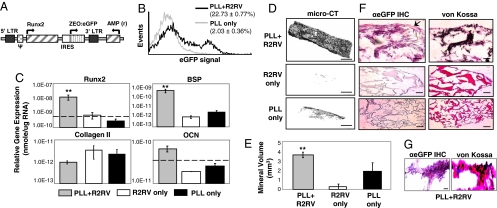Fig. 1.
Biomaterial-mediated retroviral gene delivery promotes sustained Runx2 transgene expression and osteoblastic differentiation in fibroblasts. (A) The Runx2 retroviral vector expresses the type II Runx2 isoform and a Zeocin:eGFP selectable marker from a single bicistronic mRNA transcript. Runx2 retrovirus (R2RV) was noncovalently immobilized onto fibrous collagen scaffolds coated with PLL. Primary dermal fibroblasts were then seeded onto these scaffolds and cultured in osteogenic media until endpoint assay. (B) Detection of eGFP expression by flow cytometry demonstrated sustained fibroblast transduction at 14 days postseeding. (C) Osteogenic gene expression was up-regulated within constructs uniformly coated with PLL+R2RV compared to R2RV- and PLL-only controls at 7 days postseeding. [Mean + SEM, n = 3; Runx2: ANOVA: P = 0.002, ** vs. R2RV only (P = 0.01) and PLL only (P = 0.002); Bone Sialoprotein: ANOVA: P = 0.000066, ** vs. R2RV only (P = 0.00009) and PLL only (P = 0.00023)]. (D) MicroCT images demonstrated enhanced mineral deposition on scaffolds coated with PLL+R2RV compared to R2RV- and PLL-only controls. (Scale bar: 1 mm.) (E) Quantification of mineral deposition by microCT image analysis after 49 days culture in osteogenic media. [Mean + SEM, n ≥ 4; ANOVA: P < 0.0001; ** vs. R2RV only (P = 0.00018) and PLL only (P = 0.05).] (F and G) Histological analyses demonstrated colocalization of genetically engineered fibroblasts (eGFP, pink, arrow; hematoxylin, blue) and mineral deposits (von Kossa, black), indicating that mineral deposition originated from fibroblasts that were susceptible to biomaterial-mediated viral gene delivery. (Scale bars: F, 500 μm; G, 20 μm.)

